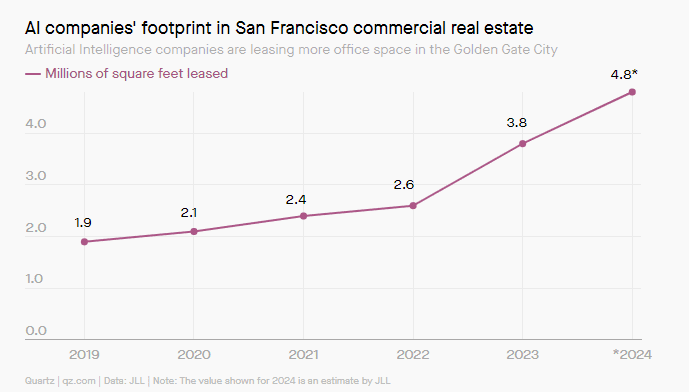TL;DR:
- San Francisco’s commercial real estate sector faced challenges due to pandemic-induced vacancy rates.
- AI startups have surged, leasing 3.6 million sq. ft. of office space in 2023, with projections to reach 12.5 million sq. ft. by 2030.
- AI firms constituted one-third of leasing activity in 2023.
- The city’s concentration of AI talent and prestigious universities attract AI companies.
- Notable AI startups, including Andi, Cohere, and Netradyne, moved or expanded to San Francisco.
- Downtown San Francisco’s economic activity contributes to 75% of the city’s GDP.
- The growth of AI companies in the area is expected to attract more businesses and fuel economic expansion.
Main AI News:
Artificial Intelligence (AI) is breathing new life into San Francisco’s commercial real estate landscape. As the city faced challenges in its commercial property sector due to rising vacancy rates caused by the pandemic-induced exodus of businesses and remote work trends, the AI sector has emerged as a game-changer.
In 2023, the office space leased by AI startups in San Francisco witnessed a staggering 46% surge, reaching 3.6 million square feet, as reported by global real estate firm Jones Lang LaSalle (JLL). Alexander Quinn, JLL’s Senior Director of Research, anticipates this figure to escalate to a remarkable 12.5 million square feet by 2030. This surge is a stark contrast to the dwindling fortunes of many established tech giants in the region.
In fact, AI firms constituted nearly one-third of all leasing activities in 2023. This surge can be largely attributed to the substantial real estate deals sealed by OpenAI and Anthropic, both of which significantly expanded their presence in the city.
While JLL predicts a slight dip in AI firms’ share of new leases in 2024, it will still remain significantly higher—about three to four times higher—than the pre-pandemic levels.
So, why are AI companies flocking to San Francisco? The answer is straightforward: the city boasts an unparalleled pool of talent. According to Quinn, approximately 20% of the nation’s AI talent is concentrated in the Bay Area. The presence of prestigious universities such as Stanford University and the University of California at Berkeley, which have nurtured AI visionaries like Sam Altman, plays a pivotal role in this talent concentration.
In 2023, several noteworthy AI startups made strategic moves to establish their roots in San Francisco. For instance, AI chatbot startup Andi relocated from Miami to downtown San Francisco, while Toronto-based AI platform Cohere set up its second headquarters in the city. AI software provider Netradyne also expanded its footprint within the Bay Area.
Tom Schmitt, Chief Financial Officer at Netradyne, emphasized, “The Bay Area continues to draw a substantial portion of the nation’s venture capital funding, solidifying its status as a pivotal location.”
The resurgence of commercial office activity in downtown San Francisco holds significant economic implications. According to city data cited by Quinn, downtown San Francisco contributes to approximately 75% of the city’s GDP. “The more we see a resurgence of the commercial office market in the downtown, the broader impacts it has on the greater economy of the Bay Area,” he emphasized.
As AI companies continue to secure more office space, they are expected to attract a multitude of other businesses to the region. Notably, the startup accelerator Y Combinator recently relocated its headquarters to San Francisco to capitalize on the city’s burgeoning AI industry. This influx of innovation and investment promises to reshape the city’s commercial real estate landscape and fuel its economic growth in the years ahead.
Conclusion:
The flourishing AI startup scene in San Francisco is revitalizing its commercial real estate sector. With a significant surge in leased office space, the city’s concentration of AI talent, and strategic relocations by prominent AI firms, the region is poised for economic growth. This trend is expected to continue, attracting more businesses and investments, ultimately reshaping the local market and contributing to the city’s economic resurgence.

